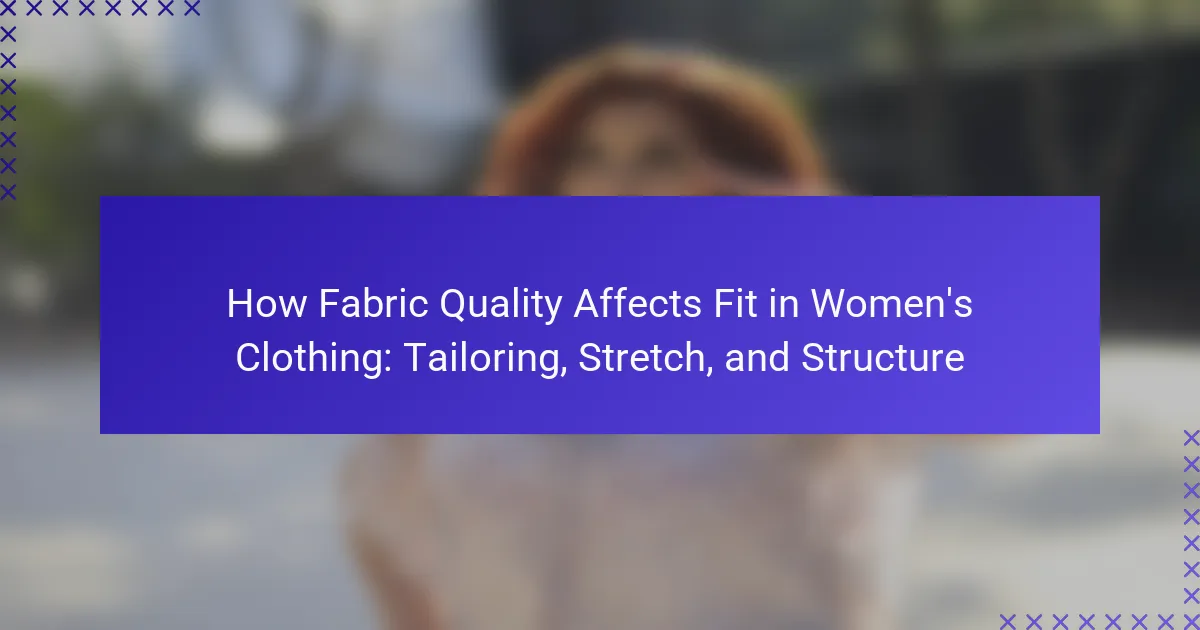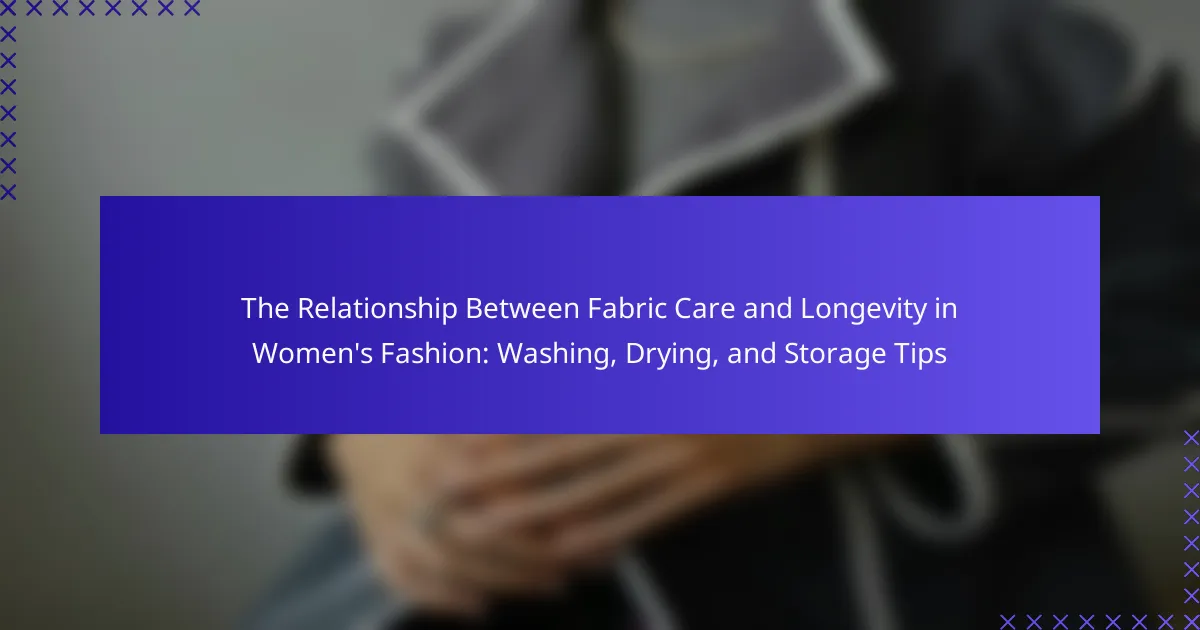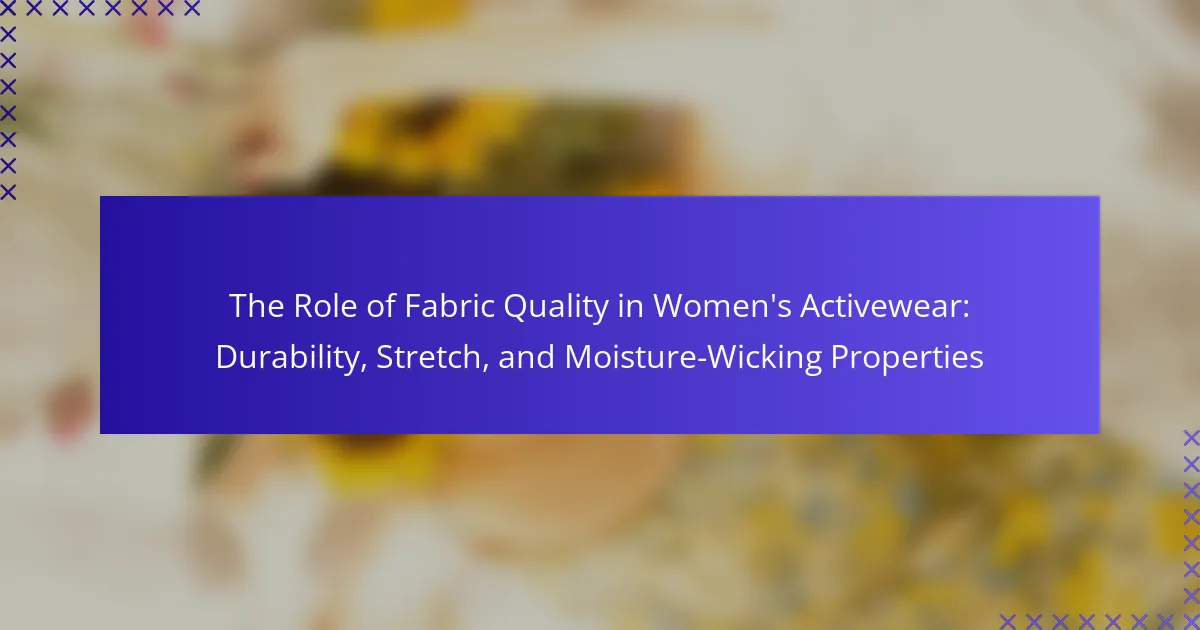Fabric quality is a crucial factor that significantly impacts the fit of women’s clothing. High-quality fabrics, such as those containing spandex blends, maintain their shape and provide a tailored silhouette, while lower-quality options may sag and lead to an unflattering appearance. Key structural elements influencing fit include fiber content, weave type, and fabric weight, which determine elasticity, drape, and how garments hang on the body. Choosing the right fabric based on these characteristics, along with considerations of breathability and structure, is essential for achieving a comfortable and flattering fit in women’s apparel.

How does fabric quality influence the fit of women’s clothing?
Fabric quality significantly influences the fit of women’s clothing. High-quality fabrics maintain their shape and structure better than lower-quality options. This results in a more tailored and flattering silhouette. Fabrics with good elasticity, such as spandex blends, allow for a comfortable fit that moves with the body. Conversely, poor-quality fabrics may sag or lose their form, leading to an unflattering appearance. Additionally, the weight of the fabric affects how it drapes on the body. Heavier fabrics tend to provide more structure, while lighter fabrics may cling or shift. Overall, fabric quality determines how well clothing conforms to body shapes and maintains its intended fit over time.
What are the key factors of fabric quality that affect fit?
The key factors of fabric quality that affect fit include stretch, weight, drape, and breathability. Stretch determines how well the fabric conforms to the body. Fabrics with higher elasticity provide a snug fit, while rigid fabrics may restrict movement. Weight influences how the fabric hangs on the body. Heavier fabrics tend to provide structure, while lighter fabrics may drape more fluidly. Drape refers to how the fabric falls and moves. Fabrics with good drape enhance the silhouette and overall appearance. Breathability affects comfort, especially in fitted garments. Fabrics that allow air circulation prevent overheating and improve wearability. Each of these factors plays a crucial role in ensuring a proper and flattering fit in women’s clothing.
How does the weight of the fabric contribute to overall fit?
The weight of the fabric directly influences the overall fit of clothing. Heavier fabrics tend to drape differently compared to lighter ones. This draping impacts how the garment conforms to the body’s shape. For example, a heavier fabric provides structure and support, enhancing the silhouette. Lighter fabrics may cling or flow, affecting the fit and appearance. Additionally, the weight can affect how the garment behaves during movement. Heavier materials often resist wrinkling and maintain their shape better. In contrast, lighter fabrics may require more careful styling to achieve a flattering fit. Thus, fabric weight is a crucial factor in determining the fit of women’s clothing.
What role does fabric composition play in achieving the desired fit?
Fabric composition significantly influences the fit of women’s clothing. Different fibers, such as cotton, polyester, and spandex, provide varying levels of stretch and structure. For instance, spandex enhances elasticity, allowing garments to conform closely to the body. Conversely, cotton offers breathability but may lack the same stretch. The blend of materials can also affect drape and how a garment falls on the body. High-quality fabrics typically maintain their shape better over time, contributing to a consistent fit. Research shows that garments made with a higher percentage of stretch fibers tend to fit more snugly and comfortably. Therefore, understanding fabric composition is essential for achieving the desired fit in women’s clothing.
Why is tailoring important in relation to fabric quality?
Tailoring is crucial for enhancing fabric quality. It ensures that garments fit the body properly. A well-tailored piece can improve the drape and appearance of the fabric. Tailoring adjusts the garment to accommodate the unique contours of the wearer. This process can highlight the fabric’s best attributes, such as texture and color. Quality fabrics require precise tailoring to maintain their integrity and enhance their visual appeal. Poorly tailored garments can lead to distortions in the fabric, diminishing its overall quality. The right tailoring can transform a standard fabric into a luxurious-looking garment.
How does tailoring enhance the fit of different fabric types?
Tailoring enhances the fit of different fabric types by adjusting garment structure to individual body shapes. Each fabric type has unique characteristics, such as stretch, drape, and weight. Tailors consider these attributes when making alterations. For instance, stretchy fabrics require different techniques compared to stiffer materials. Tailoring allows for precise adjustments that accommodate these differences. This results in a more flattering silhouette and improved comfort. Studies show that well-tailored garments can enhance overall appearance by up to 30%. Tailoring thus plays a crucial role in achieving an optimal fit across diverse fabric types.
What tailoring techniques are most effective for various fabrics?
Effective tailoring techniques vary by fabric type. For lightweight fabrics like silk, French seams provide a clean finish. This technique conceals raw edges and enhances durability. For denim, topstitching reinforces seams and adds style. It also accommodates the fabric’s weight. Wool benefits from tailoring techniques like pad stitching. This method shapes lapels and collars, ensuring structure. For knits, using a serger prevents fraying and maintains stretch. This technique is crucial for preserving the fabric’s elasticity. Lastly, for heavy fabrics like canvas, flat-felled seams add strength. They are ideal for items requiring durability. Each technique aligns with the fabric’s characteristics, ensuring quality tailoring.
How does stretch impact the fit of women’s clothing?
Stretch significantly impacts the fit of women’s clothing. It allows garments to conform to the body’s shape, enhancing comfort and mobility. Fabrics with stretch can accommodate different body types and movements. This adaptability leads to a more flattering silhouette. For instance, materials like spandex blend with cotton or polyester to provide elasticity. Research shows that 80% of women prefer clothing with some stretch for better fit and comfort. Stretch also helps garments maintain their shape after washing. Overall, stretch is a crucial factor in achieving a tailored look in women’s apparel.
What types of fabrics offer the best stretch for a flattering fit?
Fabrics that offer the best stretch for a flattering fit include spandex, elastane, and jersey. Spandex is known for its exceptional elasticity, allowing garments to retain shape. Elastane blends well with other fibers, enhancing comfort and flexibility. Jersey fabric, often made with cotton or synthetic fibers, provides a soft and stretchy feel. These fabrics conform to body shapes, promoting a flattering silhouette. Research shows that garments with a high spandex content can improve fit and movement. For instance, activewear often utilizes these materials for optimal performance and comfort.
How does the amount of stretch in a fabric affect body movement?
The amount of stretch in a fabric significantly impacts body movement. Fabrics with higher stretch allow for greater flexibility and ease of movement. This is essential for activities that require bending, stretching, or dynamic motion. For example, spandex blends provide a snug fit while enabling a full range of motion. Conversely, fabrics with little to no stretch can restrict movement and cause discomfort. Research indicates that stretchable fabrics can enhance athletic performance by improving mobility. A study published in the Journal of Textile Science found that garments with optimal stretch reduce resistance during physical activities. Thus, the stretchiness of a fabric directly influences how comfortably and effectively a person can move.
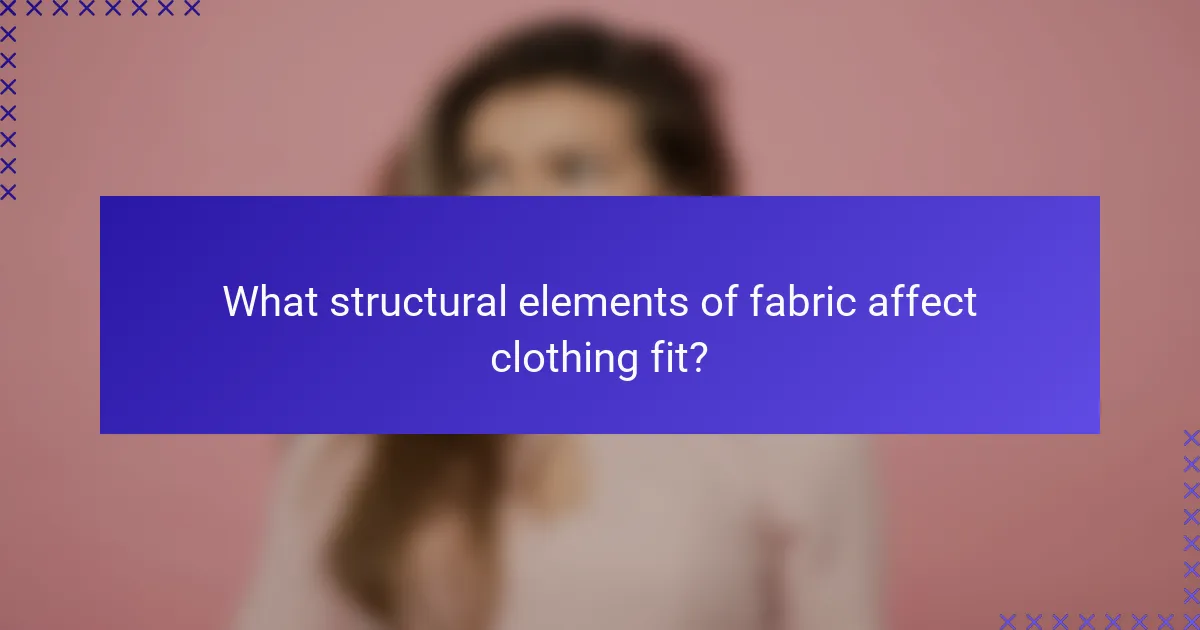
What structural elements of fabric affect clothing fit?
Structural elements of fabric that affect clothing fit include fiber content, weave type, and fabric weight. Fiber content determines the elasticity and drape of the material. For instance, fabrics with spandex offer stretch, enhancing fit. Weave type influences how the fabric conforms to body shapes. A tighter weave provides structure, while a looser weave may result in a more relaxed fit. Fabric weight affects how the garment hangs on the body. Heavier fabrics tend to drape better and provide more support. Additionally, the presence of lining can alter fit by adding structure and shaping to the garment. These elements collectively influence how well clothing fits the wearer.
How do different fabric structures influence the silhouette of women’s clothing?
Different fabric structures significantly influence the silhouette of women’s clothing. Fabric structure determines how a garment drapes, holds shape, and conforms to the body’s contours. For instance, structured fabrics like denim or canvas create a more tailored silhouette. These fabrics maintain their shape and provide support, enhancing the overall form of the garment. Conversely, fluid fabrics such as chiffon or silk create softer silhouettes. They allow for more movement and drape gently over the body.
The weight and weave of the fabric also play a crucial role. Heavier fabrics tend to create a more defined silhouette, while lighter fabrics can lead to a more flowing appearance. Additionally, fabric stretch affects fit; stretch fabrics can hug the body, emphasizing curves. Non-stretch fabrics may result in a looser fit, impacting how the silhouette is perceived.
In summary, the choice of fabric structure directly affects the silhouette by influencing drape, shape retention, and fit.
What are the differences between woven and knitted fabrics in terms of fit?
Woven fabrics generally have a more structured fit compared to knitted fabrics. Woven fabrics are created by interlacing threads at right angles, resulting in a stable and less stretchy material. This structure allows woven fabrics to maintain their shape and provide a tailored appearance. In contrast, knitted fabrics are made by interlocking loops of yarn, which gives them greater elasticity and stretch. This characteristic allows knitted fabrics to conform more closely to the body, providing a more relaxed fit. The inherent stretch in knitted fabrics enables them to accommodate movement and body contours, making them suitable for casual wear. Therefore, the primary difference in fit stems from the structural characteristics of woven versus knitted fabrics.
How does fabric structure contribute to the durability of fit over time?
Fabric structure significantly impacts the durability of fit over time. A well-constructed fabric maintains its shape and elasticity, ensuring a consistent fit. Fabrics with tighter weaves resist stretching and distortion. This resistance helps garments retain their intended silhouette. Additionally, the choice of fibers influences durability. For example, synthetic fibers often provide better shape retention than natural fibers. Research indicates that fabrics with high tensile strength withstand wear and tear more effectively. Consequently, the longevity of the garment’s fit is enhanced.
What is the relationship between fabric quality and garment longevity?
Fabric quality directly impacts garment longevity. High-quality fabrics are more durable and resistant to wear and tear. They maintain their shape and appearance over time. In contrast, low-quality fabrics tend to fade, pill, and lose structure quickly. For example, natural fibers like cotton and wool generally last longer than synthetic options. A study by the Textile Research Journal found that garments made from high-quality materials can last up to three times longer than those made from inferior fabrics. This demonstrates that investing in quality fabric leads to longer-lasting clothing.
How can high-quality fabrics maintain their shape and fit after multiple washes?
High-quality fabrics maintain their shape and fit after multiple washes due to their superior construction and material properties. These fabrics often contain high-twist yarns that provide resilience and reduce stretching. Additionally, they may incorporate synthetic fibers like polyester or elastane, which enhance durability and flexibility. The weaving techniques used, such as twill or sateen, contribute to a stable structure that resists distortion. Furthermore, high-quality fabrics undergo treatments that improve their resistance to shrinkage and fading. Studies show that fabrics with these characteristics can withstand multiple washes while retaining their original shape and fit.
What signs indicate that a fabric’s quality may be compromising fit?
Signs that indicate a fabric’s quality may be compromising fit include visible stretching or sagging. Poor-quality fabrics often lose their shape after wear. Inconsistent texture can also signal inferior quality. If the fabric feels rough or scratchy, it may not drape well. Additionally, seams that pull or pucker indicate fabric stress. A lack of elasticity can prevent proper fit, especially in stretch fabrics. Lastly, fading or discoloration may suggest low-quality dyes, affecting overall appearance and fit.
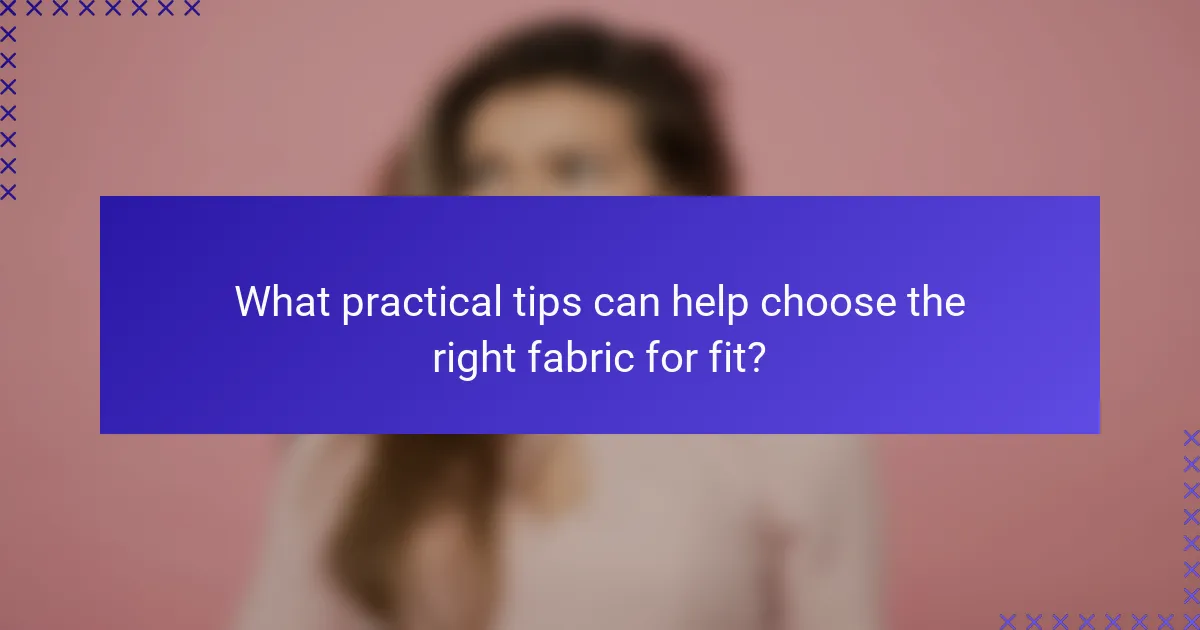
What practical tips can help choose the right fabric for fit?
Choose fabric based on its drape and stretch for the right fit. Fabrics like cotton and linen offer structure. These materials hold their shape well and provide a tailored look. Stretch fabrics such as spandex blend with other materials for flexibility. They allow for ease of movement and comfort. Consider the weight of the fabric; lighter fabrics drape differently than heavier ones. Heavier fabrics can add structure but may restrict movement. Check the fabric’s breathability; natural fibers like cotton and wool are more breathable than synthetics. Lastly, always test the fabric by holding it against your body to assess how it conforms to your shape.
How can consumers assess fabric quality before purchasing clothing?
Consumers can assess fabric quality by examining several key factors. First, they should consider the fabric’s fiber content. Natural fibers like cotton, wool, and silk generally offer better quality than synthetic fibers. Second, they can evaluate the fabric’s weight and drape. Heavier fabrics often indicate durability and better structure. Third, consumers should inspect the fabric’s finish and texture. A smooth, even surface usually signifies higher quality. Fourth, they can perform a stretch test. Fabrics with good elasticity will return to their original shape after being stretched. Lastly, checking for colorfastness is essential. High-quality fabrics resist fading and bleeding when washed. These assessments help consumers make informed choices about clothing purchases.
What characteristics should be examined when evaluating fabric for fit?
Key characteristics to examine when evaluating fabric for fit include stretch, drape, weight, and recovery. Stretch refers to the fabric’s ability to expand and return to its original shape. Fabrics with good stretch allow for better movement and comfort. Drape describes how the fabric hangs and flows on the body. A fabric with a desirable drape enhances the overall silhouette. Weight affects how the fabric sits on the body. Lighter fabrics may cling, while heavier ones provide structure. Recovery indicates how well the fabric returns to its original form after being stretched. Fabrics with excellent recovery maintain their shape over time, ensuring a consistent fit.
How can understanding fabric labels aid in selecting the best fit?
Understanding fabric labels helps in selecting the best fit by providing information on material composition and care instructions. Fabric labels typically indicate the percentage of fibers used, such as cotton, polyester, or spandex. This information is crucial because different fabrics have varying levels of stretch, breathability, and durability. For instance, fabrics with a higher spandex content offer more flexibility, which can lead to a better fit for form-fitting styles. Additionally, labels often include care instructions that inform consumers about shrinkage and maintenance, impacting the longevity and fit of the garment. By analyzing these details, shoppers can make more informed decisions, ensuring the clothing will fit well and meet their lifestyle needs.
What common mistakes should be avoided when selecting fabrics for fit?
Common mistakes to avoid when selecting fabrics for fit include choosing fabrics without considering their stretch properties. Fabrics with no stretch can restrict movement and lead to discomfort. Ignoring the weight of the fabric can also result in poor drape. Heavier fabrics may not flow well, affecting the overall silhouette. Additionally, selecting fabrics that do not match the garment style can lead to mismatched aesthetics. For example, using a stiff fabric for a flowing dress may not achieve the desired look. Lastly, overlooking fabric care requirements can affect long-term fit. Fabrics that shrink or stretch with washing may alter the garment’s shape over time.
How can one ensure that fabric choices align with personal style and comfort?
To ensure fabric choices align with personal style and comfort, one should consider both aesthetic preferences and tactile sensations. Evaluating fabric texture is crucial; soft materials like cotton or modal often enhance comfort. Additionally, identifying personal style through color and pattern preferences helps in selecting suitable fabrics. Understanding the drape of fabrics can influence how they fit and feel on the body. For instance, structured fabrics may provide a tailored look, while flowy materials offer a relaxed vibe. Testing fabrics against the skin can reveal comfort levels, as some may irritate sensitive skin. Ultimately, combining style objectives with comfort needs leads to better fabric selections.
The main entity of the article is fabric quality and its impact on the fit of women’s clothing. The article explores how factors such as stretch, weight, drape, and breathability influence garment fit, highlighting the importance of high-quality fabrics in achieving a flattering silhouette. It also discusses the role of tailoring in enhancing fit and the differences between woven and knitted fabrics. Additionally, practical tips for assessing fabric quality and making informed fabric choices are provided to ensure comfort and style alignment.
